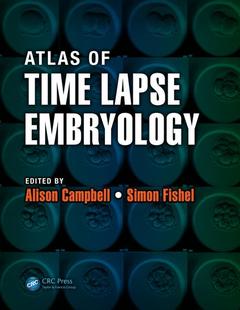Atlas of Time Lapse Embryology
Coordonnateurs : Campbell Alison, Fishel Simon

Unlike conventional single daily observations, time lapse technology provides hundreds of images, which allows pinpointing of key events in the embryo?s in vitro development as well as the detection of brief but significant critical changes. This information is beneficial in selecting the most viable embryos from a cohort and increases the chances of a positive outcome.
The Atlas of Time Lapse Embryology describes in detail the technology and techniques surrounding time lapse embryology.The book also covers the clinical aspects of time lapse imaging, morphokinetic timings, implantation data, fertilization, compaction, blastulation, irregular cleavages, multinucleation, vacuolation, zona defects, and other topics.
The book is easy to read, practical, and illustrated with dozens of images and video clips to help explain a variety of concepts. It will help practitioners to better understand how time lapse monitoring may dramatically increase flexibility in the IVF clinic, and most importantly, enhance clinical outcomes.
Print Versions of this book also include access to the ebook version.
Equipment Required for Time Lapse Observations in In Vitro Fertilization. Clinical Aspects of Time Lapse Imaging. Time Lapse, the Cell Cycle, Distribution of Morphokinetic Timings, and Known Implantation Data. Gender and Morphokinetics Correlation. Polar-Body Extrusion. Fertilization: Pronuclear Formation and Fading. Clinical Results: Dynamic Aspects—Fragmentation. Number of Pronuclei and Ploidy in IVF /ICSI—Derived Embryos. Dynamic Aspects: Compaction. Blastulation. Hatching of the Human Blastocyst. Irregular Cleavages. Reverse Cleavage/Blastomere Fusion. Smooth Endoplasmic Reticulum Clusters. Multinucleation. Vacuolation. Granular Cytoplasm. Zona Defects. The Patient Perspective.
Edited by
Alison Campbell, M. Med. Sci, head of embryology, CARE Fertility Group, Nottingham, UK
Simon Fishel, PhD, professor of human reproduction and CEO, CARE Fertility Group, Nottingham, UK
Date de parution : 03-2015
21x28 cm
Thème d’Atlas of Time Lapse Embryology :
Mots-clés :
ICSI; Time Lapse Imaging; images; Care Fertility; transfer; Polar Body; polar; Morphokinetic Variables; body; Embryo Transfer; development; IVF; monitoring; Time Lapse Technology; technology; 2PN Zygote; microscopy; Embryo’s Development; extrusion; Polar Body Extrusion; blastocyst; ZP; Zona Pellucida; Time Lapse System; Time Lapse Monitoring; Embryo Selection; Morphokinetic Data; Preimplantation Embryo Development; ZP3; Blastocyst Stage; Meiotic Spindle; IVF Laboratory; Time Lapse Study; Implantation Data; ESHRE



